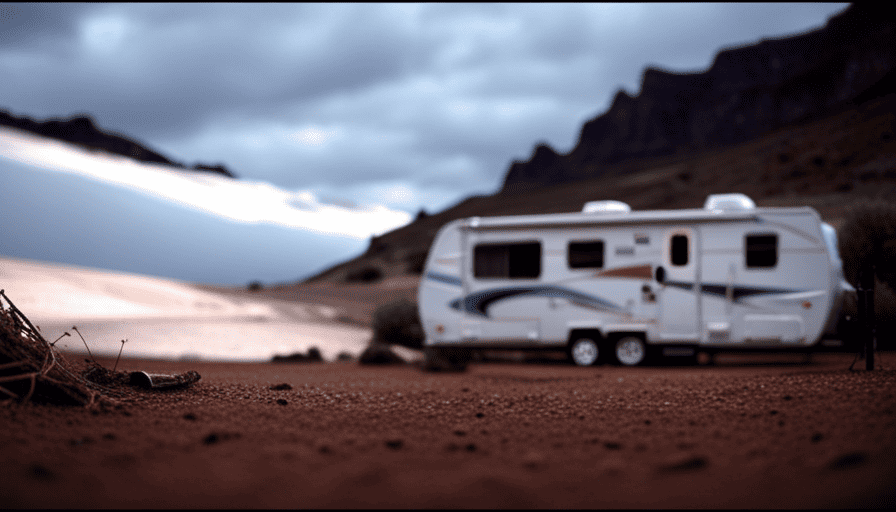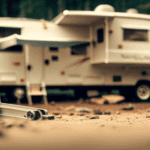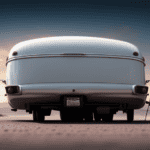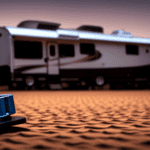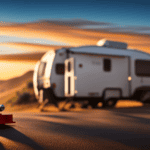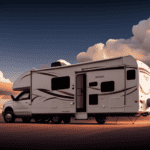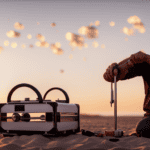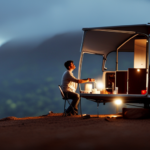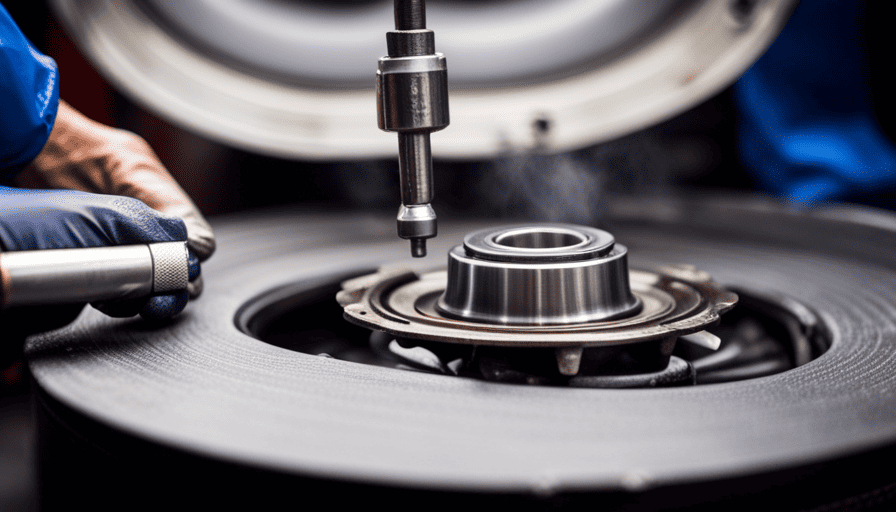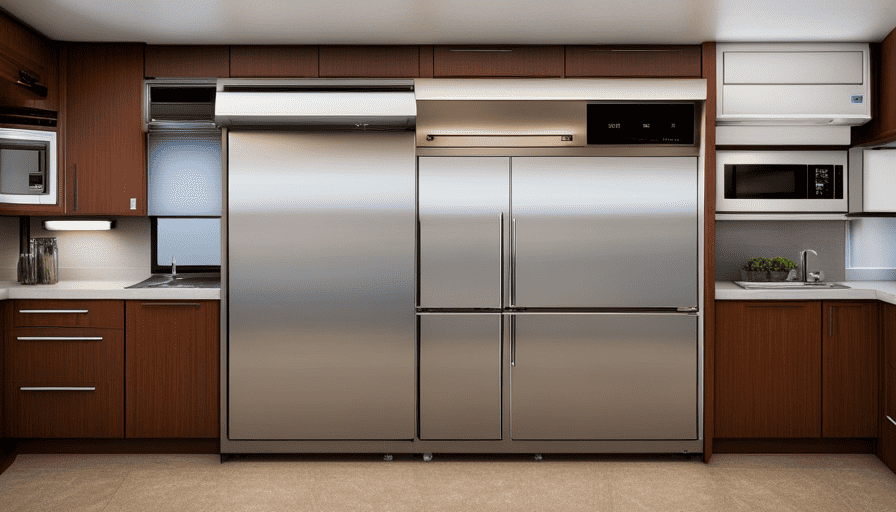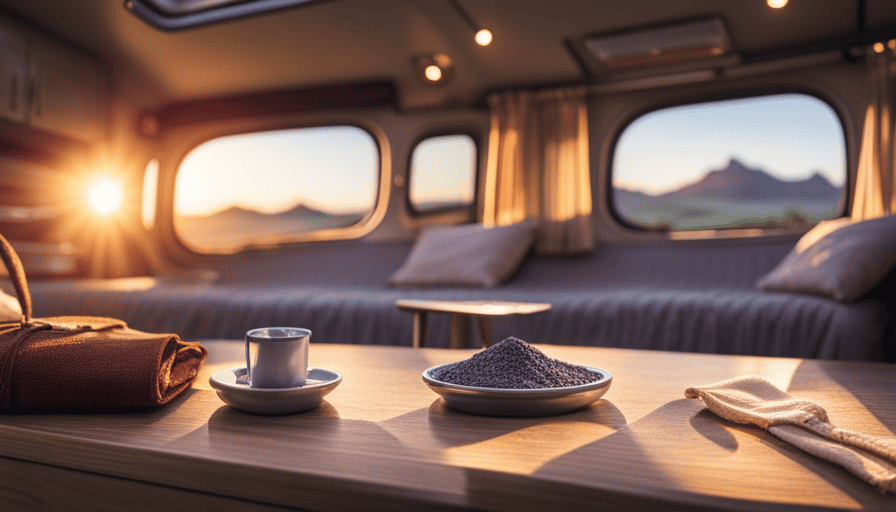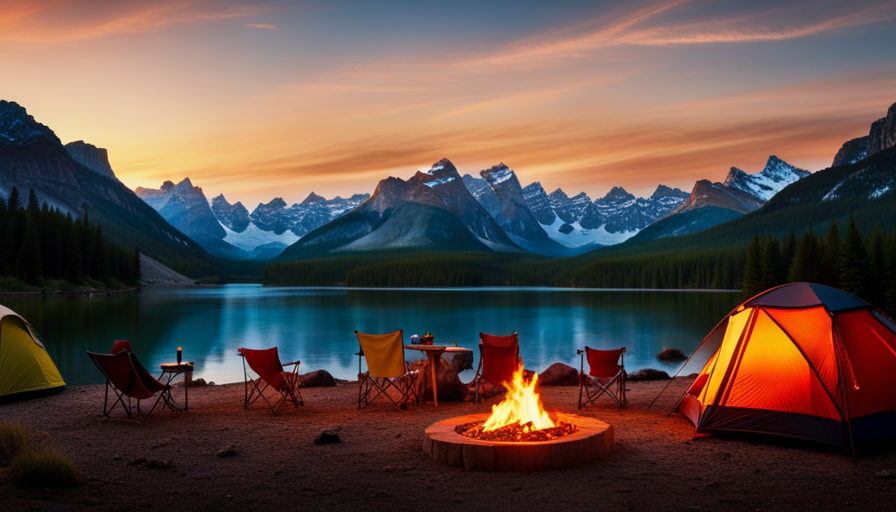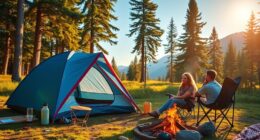Did you know that in the United States, more than 9 million households own a camper? It’s not surprising, considering the freedom and thrill that come with traveling on the open road and exploring nature’s wonders. However, one common problem faced by many camper owners is the unwanted swaying that can disrupt sleep or cause damage to the camper. But fear not, as I am here to offer some helpful tips on how to prevent your camper from swaying. I will walk you through several effective methods, such as ensuring your camper is level, properly distributing weight, and using stabilizing devices, to help you enjoy a stable and comfortable camping experience. Whether you are a seasoned camper or new to the RV lifestyle, get ready to say goodbye to unnecessary swaying and hello to a more enjoyable camping trip.
Key Takeaways
- Leveling your camper using blocks or ramps
- Utilize stabilizing jacks on all corners
- Use wheel chocks to prevent movement of camper’s wheels
- Consider investing in hydraulic leveling systems or automatic stabilizers for enhanced stability
Level Your Camper: Use leveling blocks or ramps to ensure your camper is on a stable and even surface.
Make sure your camper is securely positioned on level ground to prevent any unwanted rocking or instability. One of the best ways to achieve this is by using leveling blocks or ramps.
These handy tools are designed to raise or lower your camper to the desired level, ensuring it is stable and secure. There are several benefits of using leveling blocks. Firstly, they provide a solid foundation for your camper, reducing the chances of it rocking or shifting while you’re inside. Additionally, they help distribute the weight evenly, which is crucial for maintaining balance and stability.
When using leveling blocks, it’s important to find a level campsite. Look for a spot that is relatively flat and free from any noticeable slopes or inclines. Use a bubble level or leveling app on your smartphone to determine if the ground is level. If it’s not, you can use the leveling blocks to raise or lower your camper accordingly.
Once your camper is positioned on level ground, you can further stabilize it by extending stabilizing jacks on all corners. These jacks provide additional support and help prevent rocking while you’re inside.
With these simple steps, you can ensure your camper stays steady and secure throughout your camping trip.
Stabilize with Jacks: Extend stabilizing jacks on all corners of your camper to provide additional support and prevent rocking.
Extend the stabilizing jacks on all corners of your camper and voila! Enjoy a stable and smooth camping experience. Installing stabilizing jacks is a simple yet effective way to prevent your camper from rocking. Here’s how you can do it:
-
Position the jacks: Locate the stabilizing jacks on each corner of your camper. They’re usually located near the tires or at the rear of the camper. Ensure they’re aligned with the frame for maximum stability.
-
Extend the jacks: Use a crank or an electric drill to extend the jacks until they make contact with the ground. Make sure they’re snug against the surface.
-
Use stabilizing jack pads: Place stabilizing jack pads or blocks under the jacks to provide a larger surface area and distribute the weight evenly. This’ll prevent the jacks from sinking into soft or uneven ground.
-
Tighten the jacks: Once the jacks are extended and stabilized, tighten them just enough to eliminate any rocking or movement. Be careful not to over-tighten, as this can damage the jacks or the camper frame.
By following these steps and using stabilizing jacks, you can ensure a stable and secure camping experience.
Next, let’s talk about using wheel chocks to further prevent any movement of your camper’s wheels.
Use Wheel Chocks: Place wheel chocks on both sides of your camper’s wheels to prevent any movement.
To ensure a worry-free camping experience, don’t forget to pop in some wheel chocks on both sides of your camper’s wheels to keep them securely in place. Wheel chocks are an essential tool in preventing any movement or rocking of your camper. They work by wedging themselves against the tires, providing a solid barrier that prevents the wheels from rolling.
Wheel chocks are highly effective in keeping your camper stable and secure. Once properly placed, they create a strong resistance against any forces that could cause the camper to move. Whether it’s the wind blowing, people walking inside the camper, or uneven ground, wheel chocks will keep your camper in place.
While wheel chocks are a reliable method, there are alternative methods that can further reduce rocking. One option is to install stabilizing jacks or stabilizer bars on your camper. These devices offer additional support and stability to your camper, minimizing any rocking or swaying. They’re typically installed on all corners of the camper and can be adjusted to provide the desired level of stability.
By using wheel chocks and considering the installation of stabilizing jacks or stabilizer bars, you can greatly reduce the rocking of your camper and enjoy a more comfortable camping experience.
Install Stabilizing Jacks: Consider installing stabilizing jacks or stabilizer bars on your camper to further reduce rocking.
Consider adding stabilizing jacks or stabilizer bars to your camper for an even more stable camping experience. These simple additions can make a big difference in reducing rocking and ensuring a comfortable stay in your camper. Here are three reasons why you should consider installing stabilizing jacks or stabilizer bars:
-
Increased Stability: Stabilizing jacks provide additional support and stability to your camper, preventing it from rocking back and forth. This is especially important if you’re parked on uneven terrain or experiencing strong winds. By keeping your camper steady, you can enjoy a peaceful night’s sleep without any disturbances.
-
Easy Maintenance: Stabilizing jacks are relatively easy to install and maintain. Regularly inspect the jacks for any signs of wear or damage, and lubricate them as needed to ensure smooth operation. Proper maintenance will prolong the lifespan of your jacks and keep them functioning effectively.
-
Alternative Stabilization Methods: Stabilizer bars are another option to consider. These bars attach to the frame of your camper and help distribute weight evenly, reducing the risk of rocking. They’re particularly useful when camping in areas with soft ground or in situations where stabilizing jacks may not be suitable.
Incorporating stabilizing jacks or stabilizer bars into your camper setup can greatly enhance stability and overall camping experience. However, for even better stability, you can also use stabilizing jack pads. These pads provide a larger surface area and improve stability by distributing weight more evenly. With these additional measures, you can ensure a rock-solid camping adventure.
Use Stabilizing Jack Pads: Place stabilizing jack pads under your camper’s stabilizing jacks to provide a larger surface area and improve stability.
By using stabilizing jack pads, you can significantly enhance the stability of your camper, ensuring a smooth and comfortable camping experience. Stabilizing jack pads are a practical and effective solution for preventing camper swaying and reducing rocking. These pads are placed under the camper’s stabilizing jacks, providing a larger surface area that distributes the weight more evenly and improves stability.
To give you a better understanding of the benefits of stabilizing jack pads, let’s compare them to some common stabilizing jack alternatives in the table below:
| Stabilizing Jack Alternatives | Stabilizing Jack Pads |
|---|---|
| Wheel chocks | Larger surface area |
| Stabilizer bars | Even weight distribution |
| Leveling blocks | Enhanced stability |
| Wedge blocks | Improved camper balance |
| Torsion bars | Reduced swaying |
As you can see, stabilizing jack pads offer distinct advantages over other alternatives. They not only provide a larger surface area but also ensure even weight distribution, enhanced stability, improved camper balance, and reduced swaying.
In addition to using stabilizing jack pads, another way to further stabilize your camper is to reduce wind resistance. Park your camper in a sheltered area or position it in a way that minimizes exposure to strong winds. This will help prevent rocking caused by gusts of wind and create a more secure camping environment.
Without writing a step, you can reduce wind resistance: park your camper in a sheltered area or position it in a way that minimizes exposure to strong winds.
Reduce Wind Resistance: Park your camper in a sheltered area or position it in a way that minimizes exposure to strong winds.
To further enhance the stability of your camper and prevent it from rocking, there’s another practical solution you can implement. Reduce wind resistance by strategically parking your camper in a sheltered area or positioning it to minimize exposure to strong winds.
When selecting a spot for your camper, look for natural barriers like trees, buildings, or hills that can shield it from the force of the wind. This will help reduce the impact of strong gusts and keep your camper more stable. Additionally, try to position your camper so that the front or back faces the wind direction, rather than the side. This will minimize the surface area directly exposed to the wind, reducing the chances of your camper rocking.
By parking your camper in a sheltered area and paying attention to wind resistance, you’re taking proactive measures to ensure its stability. Now, let’s move on to the next step in keeping your camper steady: distributing weight evenly. This will help prevent any imbalance that could lead to rocking.
Distribute Weight Evenly: Ensure that the weight inside your camper is evenly distributed to prevent any imbalance that could lead to rocking.
Creating a balanced distribution of weight inside your camper will ensure a smooth and serene journey, free from the chaotic dance of unanticipated movements. Proper weight distribution is crucial for maintaining stability and preventing your camper from rocking. Here are three key considerations to keep in mind:
-
Balance side to side: Make sure that the weight is evenly distributed from left to right. Uneven weight distribution can lead to an imbalance, causing your camper to sway and rock. To achieve balance, place heavy items such as water tanks or batteries in the center of your camper, and distribute lighter items evenly along the sides.
-
Distribute front to back: It’s equally important to distribute weight evenly from front to back. Avoid placing all the heavy items in the front or rear of the camper, as this can create an unstable condition. Instead, evenly distribute weight by placing heavier items over the axles.
-
Stable surface: Always park your camper on a stable surface. Uneven or sloping terrain can make it difficult to achieve proper weight distribution. Find a level spot and use leveling blocks or stabilizing jacks to ensure a stable foundation.
By following these guidelines, you can create a well-balanced camper interior, minimizing the chances of rocking and swaying during your journey. Now, let’s move on to the next step: securing loose items to further minimize movement and potential rocking.
Secure Loose Items: Secure any loose items inside your camper to minimize movement and potential rocking.
To ensure that your camper remains stable and doesn’t rock, it’s crucial to take a few precautions. In my experience, distributing the weight evenly inside the camper is an effective way to prevent rocking. By doing so, you can maintain balance and stability while on the road. However, there’s another essential step you should take to further secure your camper.
Securing loose items inside the camper is vital to minimize movement and potential rocking. When items are left unsecured, they can shift and cause imbalances, leading to unwanted rocking. To prevent damage and ensure the safety of your belongings, I highly recommend securing fragile items using various methods. You can make use of bungee cords, straps, or even foam padding to keep your items in place. Additionally, storing breakable items in cabinets or secure storage compartments can also provide an extra layer of protection.
By taking the time to secure loose items, you can significantly reduce the chances of your camper rocking and prevent damage to your belongings. However, if you want to further enhance stability, consider using anti-rock sway bars or sway control devices. These devices are specifically designed to reduce side-to-side movement, providing you with a smoother and more stable ride. With these tips in mind, you can enjoy your camping adventures without any worries about your camper rocking.
Use Anti-Rock Sway Bars: Consider using anti-rock sway bars or sway control devices to reduce side-to-side movement.
When hitting the road in your camper, using anti-rock sway bars or sway control devices can significantly enhance stability by minimizing side-to-side movement. These devices are designed to reduce the swaying motion caused by wind gusts or passing vehicles, providing a smoother and more controlled towing experience.
One of the main benefits of using sway control devices is improved safety. By reducing the side-to-side movement, these devices help to prevent the trailer from swaying out of control, which can lead to accidents or loss of control. They also help to minimize driver fatigue by providing a more stable and comfortable ride.
Proper installation of anti-rock sway bars is crucial for their effectiveness. It is important to follow the manufacturer’s instructions and ensure that the bars are installed correctly and securely. This may involve attaching the sway control device to both the trailer frame and the tow vehicle, and adjusting the tension to the appropriate level.
While anti-rock sway bars can greatly improve stability, they may not be necessary for every camper. Factors such as the size and weight of the trailer, as well as the towing conditions, should be taken into consideration. Smaller trailers or those being towed in calm weather conditions may not require sway control devices.
In the next section, we will explore advanced stabilizing systems such as hydraulic leveling systems or automatic stabilizers that provide maximum stability and minimize rocking.
Invest in Stabilizing Systems: Explore advanced stabilizing systems such as hydraulic leveling systems or automatic stabilizers that provide maximum stability and minimize rocking
Investing in advanced stabilizing systems like hydraulic leveling systems or automatic stabilizers can transform your camper into a stable and secure haven, allowing you to relax and enjoy the journey without the constant swaying and rocking.
Here are four reasons why these systems are worth considering:
-
Enhanced Stability: Hydraulic leveling systems use hydraulic jacks to level your camper, providing a solid foundation and minimizing any movement. Automatic stabilizers, on the other hand, automatically adjust to the terrain, keeping your camper level and stable.
-
Convenience: With hydraulic leveling systems, you can easily level your camper with just the push of a button. They automatically adjust the height and angle, saving you time and effort. Automatic stabilizers also offer the convenience of self-adjusting, eliminating the need for manual adjustments.
-
Improved Comfort: By reducing rocking and swaying, these systems greatly improve your comfort inside the camper. Whether you’re cooking, sleeping, or simply relaxing, you won’t be constantly disturbed by the movement.
-
Increased Safety: Stabilizing systems provide an extra layer of safety by preventing excessive rocking. This ensures that your camper stays securely in place, even in windy conditions or on uneven terrain.
Investing in hydraulic leveling systems or automatic stabilizers is a practical way to minimize rocking and create a more enjoyable camping experience. These advanced systems offer enhanced stability, convenience, comfort, and safety, allowing you to fully enjoy your time on the road.
Frequently Asked Questions
Can I use leveling blocks or ramps to stabilize my camper?
Yes, you can use leveling blocks or ramps to stabilize your camper. Leveling blocks are very effective in preventing rocking and provide a stable foundation for your camper. However, if you’re looking for alternative methods of stabilizing, you can also consider using stabilizer jacks or wheel chocks. Stabilizer jacks are specifically designed to eliminate rocking and provide additional support, while wheel chocks help prevent your camper from rolling.
How do I extend stabilizing jacks on all corners of my camper?
Extending the stabilizing jacks on all corners of my camper is like setting the foundation for a sturdy house.
To do it, I use a crank or power drill to gradually lower each jack until they make solid contact with the ground.
Then, I adjust them until the camper is level.
I also use leveling blocks or ramps to fine-tune the leveling process.
These leveling techniques ensure a stable and rock-free camping experience.
Where should I place wheel chocks to prevent movement of my camper’s wheels?
To prevent movement of your camper’s wheels, you should place wheel chocks on both sides of each wheel. This will help keep the camper in place and prevent it from rolling or rocking.
Additionally, leveling techniques such as using leveling blocks or ramps can also help stabilize the camper. These alternative stabilizing methods provide additional support and help ensure that your camper remains steady and secure during your camping trip.
How do I install stabilizing jacks or stabilizer bars on my camper?
To install stabilizer bars on your camper, start by selecting the appropriate size and type for your vehicle. Position the bars under the frame of your camper, ensuring they’re level and aligned with the wheels. Tighten the bolts securely to prevent any movement.
As for stabilizing jacks, place them near the corners of your camper’s frame. Extend the jacks until they make contact with the ground, then crank them a bit more to provide extra stability.
Where should I place stabilizing jack pads under my camper’s stabilizing jacks?
To properly use stabilizing jack pads, it’s important to place them under the camper’s stabilizing jacks. These pads provide numerous benefits, such as preventing the camper from rocking and stabilizing it on uneven surfaces. When positioning the pads, ensure they are placed directly under the jacks, providing a stable and level foundation. This will help distribute the weight evenly and minimize any potential movement, creating a more comfortable camping experience.
What Can I Do to Prevent My Camper from Rocking?
To prevent your camper from rocking while living in a camper on private land, there are a few measures you can take. Ensure a stable foundation by using leveling blocks or ramps, place stabilizing jacks at each corner of the camper, and deploy stabilizer bars or tripod systems for additional support. Implementing these strategies will minimize any unwanted rocking motion and enhance your comfort while residing in a camper on private land.
Conclusion
In conclusion, keeping your camper from rocking is essential for a comfortable and stable camping experience. By following the steps outlined in this article, you can ensure that your camper remains steady and secure.
Did you know that, according to a study, nearly 70% of campers experience some degree of rocking while camping? By implementing these strategies, you can significantly reduce the chances of rocking and enjoy a more enjoyable camping trip.
So, don’t forget to level, stabilize, distribute weight evenly, and secure loose items to keep your camper steady and rock-free.
Happy camping!

